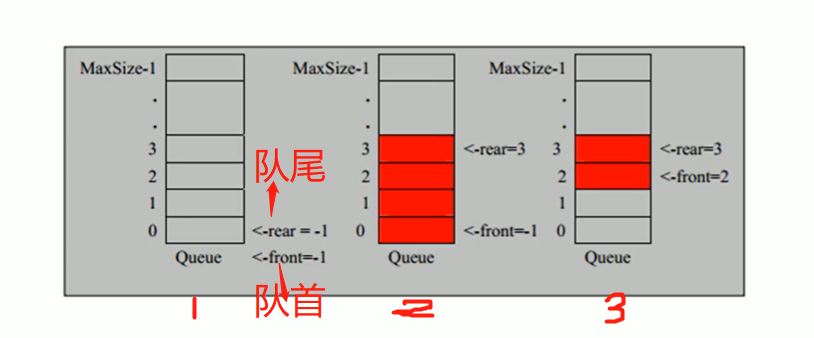【小白學演算法】3. 佇列
阿新 • • 發佈:2021-03-11
### 一、什麼是佇列
* 佇列是一個有序列表,可以用陣列或者連結串列來實現。
* 遵循**先入先出**的原則,即:先存入佇列的資料,要先取出。後存入的的資料,後取出。
看一張佇列的模擬圖,1,2,3表示同一個佇列Queue。
在佇列中有2個指標,front表示隊首,rear表示隊尾。
1. 圖1中表示佇列裡還沒有資料,所以front跟rear初始化都是-1。
2. 當圖2中有資料進行存入的時候,front沒變,而rear則隨著資料的增多而改變。存入了4個數據,於是rear=3。
3. 再看圖3,front變成了2,rear沒有變化,因為前面的2個數據被依次先取出,所以隊首就變成了2。

這就是佇列的“先進先出”了。
### 二、用陣列來模擬佇列
思路也比較簡單,因為佇列的輸出、輸入是分別從前後端來處理,因此需要兩個變數front以及rear分別記錄佇列的
前後端下標。front會隨著資料輸出而改變,而rear則是隨著資料的輸入而改變。
```
package sparsearray;
import java.util.Scanner;
public class MyArrayQueue {
public static void main(String[] args) {
// 建立一個佇列
ArrayQueue arrayQueue = new ArrayQueue(3);
char key = ' '; //接受使用者輸入
Scanner scanner = new Scanner(System.in);
boolean loop = true;
// 輸出一個選單
while (loop) {
System.out.println("s(show): 顯示佇列");
System.out.println("e(exit): 退出程式");
System.out.println("a(add): 新增資料到佇列");
System.out.println("g(get): 從佇列取出資料");
System.out.println("h(head): 顯示隊首的資料");
key = scanner.next().charAt(0); // 接收一個字元
switch (key) {
case 's':
arrayQueue.showQueue();
break;
case 'a':
System.out.println("請要新增的數");
int value = scanner.nextInt();
arrayQueue.addQueue(value);
break;
case 'g':
try {
int res = arrayQueue.getQueue();
System.out.printf("取出的資料是:%d", res);
} catch (Exception e) {
System.out.println(e.getMessage());
}
break;
case 'h':
try {
int headValue = arrayQueue.showHeadQueue();
System.out.printf("隊首資料是:%d", headValue);
} catch (Exception e) {
System.out.println(e.getMessage());
}
break;
case 'e':
scanner.close();
loop = false;
break;
}
}
System.out.println("退出程式");
}
}
// 把佇列抽象成一個類,ArrayQueue
class ArrayQueue {
//表示陣列最大容量
private int maxSize;
// 佇列頭
private int front;
// 佇列尾
private int rear;
// 用於存放資料的陣列
private int[] arr;
// 構造器
public ArrayQueue(int arrMaxSize) {
maxSize = arrMaxSize;
arr = new int[maxSize];
front = -1; // 指向隊首的前一個位置
rear = -1; // 指向佇列尾部,包括佇列最後的這個資料
}
// 判斷佇列是否已經存滿
public boolean isFull() {
return rear == maxSize - 1; // 注意這裡的 maxSize-1 為什麼要減1
}
// 判斷佇列是否為空
public boolean isEmpty() {
return rear == front;
}
// 新增資料到佇列
public void addQueue(int num) {
// 判斷佇列是否滿了
if (isFull()) {
System.out.println("佇列已滿,不可加入資料");
return;
}
rear++; // 讓rear後移
arr[rear] = num;
}
// 拿出佇列資料
public int getQueue() {
// 判斷佇列是否空
if (isEmpty()) {
// 丟擲異常
throw new RuntimeException("佇列為空,不可取資料");
}
front++; // front後移
return arr[front];
}
// 顯示佇列所有資料
public void showQueue() {
// 遍歷
if (isEmpty()) {
System.out.println("佇列為空");
return;
}
for (int i = 0; i < arr.length; i++) {
System.out.printf("arr[%d]=%d\n", i, arr[i]);
}
}
// 顯示隊裡的隊首資料
public int showHeadQueue() {
if (isEmpty()) {
// 丟擲異常
throw new RuntimeException("佇列為空,不可取資料");
}
return arr[front + 1]; // 注意這裡為甚麼要+1,因為指向隊首的前一個位置
}
}
```
可以用程式碼分別的進行各項操作,看起來似乎沒問題。
但是,實際是有問題。
這裡建立的陣列使用一次就不能接著用了,比如把資料取完後,再往裡加資料就不行了。
所以要對其進行優化,使用演算法,將其改成一個環形佇列,取模:%。
下一章
